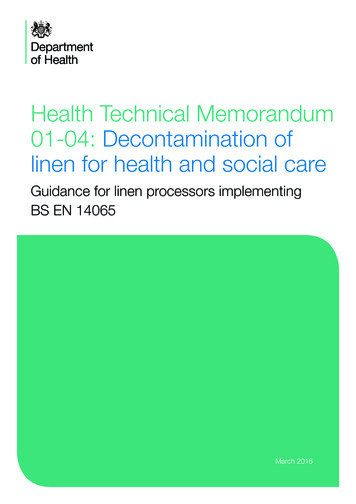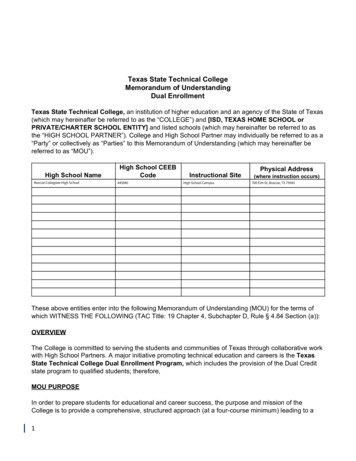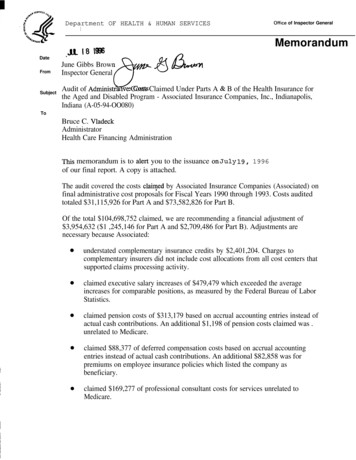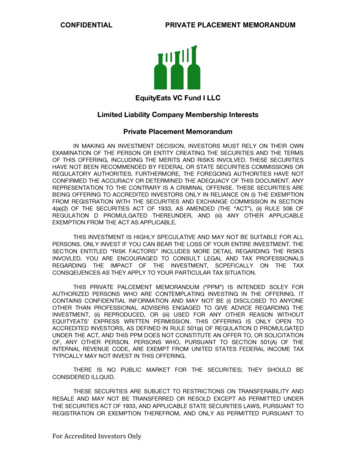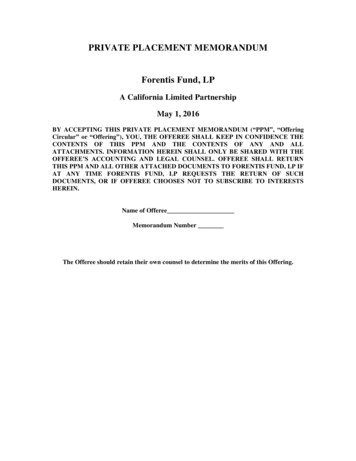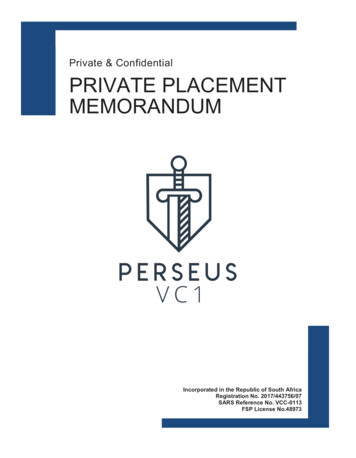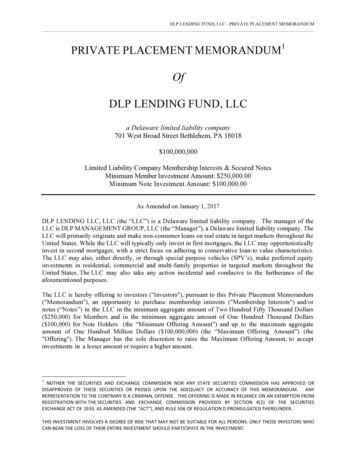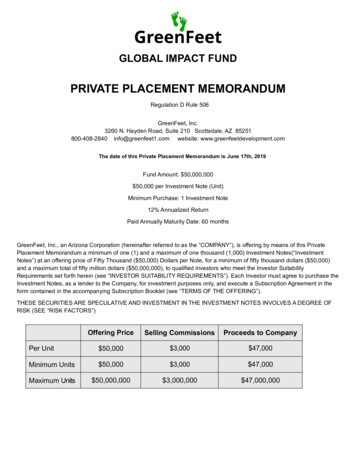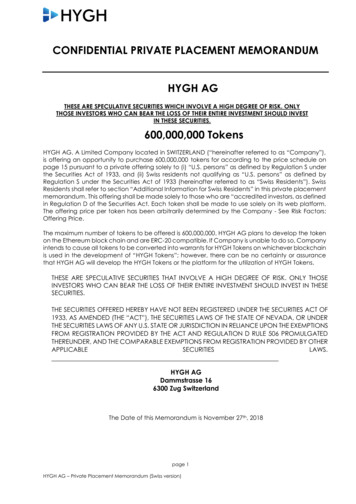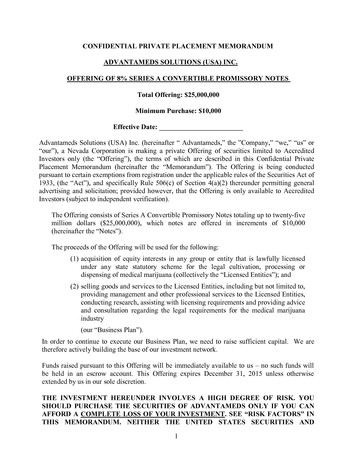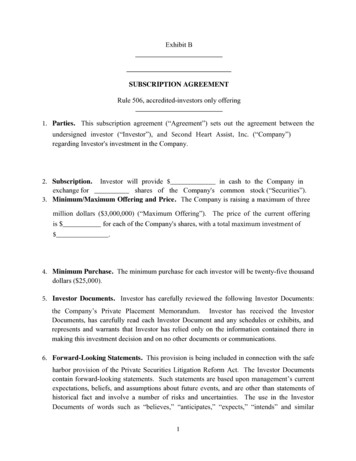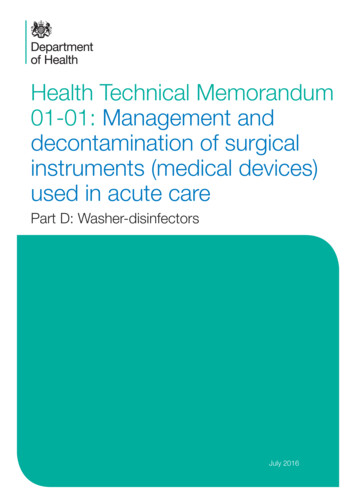
Transcription
Health Technical Memorandum01-01: Management anddecontamination of surgicalinstruments (medical devices)used in acute carePart D: Washer-disinfectorsJuly 2016
HTM 01-01: Management and decontamination of surgical instruments: Part D – Washer-disinfectorsHealth Technical Memorandum01-01: Management anddecontamination of surgicalinstruments (medical devices)used in acute carePart D: Washer-disinfectorsii
Crown copyright 2016You may re-use this information (not including logos) free of charge in any format or medium, under the terms of the Open Government Licence. To view this licence, visit www.nationalarchives. gov.uk/doc/open-government-licence/ or write to the Information PolicyTeam, The National Archives, Kew, London TW9 4DU, or email: psi@nationalarchives.gsi.gov.uk.This document is available from our website at notes-core-elementsiii
HTM 01-01: Management and decontamination of surgical instruments: Part D – Washer-disinfectorsPrefaceIntroductionThis HTM supersedes the Choice Frameworkfor local Policy and Procedures (CFPP) series,which was a pilot initiative by the Department ofHealth.The CFPP series of documents are reverting tothe Health Technical Memorandum title format.This will realign them with HTM 00 – ‘Policiesand principles of healthcare engineering’ and‘HTM 01-05: Decontamination in primary caredental practices’ and the naming conventionused for other healthcare estates and facilitiesrelated technical guidance documents withinEngland. It will also help to address therecommendation to align decontaminationguidance across the four nations.In 01-01 and 01-06 DH will be retaining theEssential Quality Requirements and BestPractice format, this maintains their alignmentwith HTM 01-05 and the requirement of ‘TheHealth and Social Care Act 2008: Code ofPractice on the prevention and control ofinfections and related guidance’ which requiresthat “decontamination policy shoulddemonstrate that it complies with guidanceestablishing essential quality requirements anda plan is in place for progression to bestpractice”. We are aware that policy within thedevolved nations differs on this particular issuebut the aim is that the technical content shouldbe consistent and able to be adopted by thedevolved nations so that the requirements ofthe ACDP-TSE Subgroup’s amended guidancecan be met.ivHTM 01-01 forms a suite of evidence-basedpolicy and guidance documents on themanagement and decontamination of reusablemedical devices.PurposeThe purpose of this HTM is to help healthorganisations to develop policies regarding themanagement, use and decontamination ofreusable medical devices at controlled costsusing risk control, which will enable them tocomply with Regulations 12(2)(h) and 15 of theHealth and Social Care Act 2008 (RegulatedActivities) Regulations 2014 .This HTM is designed to reflect the need tocontinuously improve outcomes in terms of: patient safety; clinical effectiveness; and patient experience.Essential Quality Requirements andBest PracticeThe Health Act Code of Practice recommendsthat healthcare organisations comply withguidance establishing Essential QualityRequirements and demonstrate that a plan is inplace for progression to Best Practice.Essential Quality Requirements (EQR), for thepurposes of this best practice guidance, is aterm that encompasses all existing statutoryand regulatory requirements. EQRs incorporaterequirements of the current Medical Devices
Directive and Approved Codes of Practice aswell as relevant applicable Standards. They willhelp to demonstrate that an acute provideroperates safely with respect to itsdecontamination services.A healthcare provider’s policy should definehow it achieves risk control and what plan is inplace to work towards Best Practice.Best Practice is additional to EQR. BestPractice as defined in this guidance coversnon-mandatory policies and procedures thataim to further minimise risks to patients; deliverbetter patient outcomes; promote andencourage innovation and choice; and achievecost efficiencies.Best Practice should be considered whendeveloping local policies and procedures basedon the risk of surgical procedures and availableevidence. Best Practice encompassesguidance on the whole of the decontaminationcycle, including, for example, improvedinstrument management, where there isevidence that these procedures will contributeto improved clinical outcomes.The HTM 01 suite is listed below. HTM 01-01: Management anddecontamination of surgical instruments(medical devices) used in acute care HTM 01-04: Decontamination of linen forhealth and social care HTM 01-05: Decontamination in primarycare dental practices [check title] HTM 01-06: Decontamination of flexibleendoscopes.NoteThis guidance remains a work in progresswhich will be updated as additional evidencebecomes available; each iteration of theguidance is designed to help toincrementally reduce the risk of crossinfection.v
HTM 01-01: Management and decontamination of surgical instruments: Part D – Washer-disinfectorsAbbreviationsACDP-TSE [Subgroup]: Advisory Committee onDangerous Pathogens – TransmissibleSpongiform Encephalopathies [Subgroup]DH: Department of HealthAE(D): Authorising Engineer (Decontamination)HBN: Health Building NoteAP(D): Authorised Person (Decontamination)ISO: International Standards OrganisationBS: British StandardMAT: minimal access therapyBSA: bovine serum albuminMHRA: Medicines and Healthcare productsRegulatory AgencyCFPP: Choice Framework for local Policy andProceduresEN: European normPCD: process challenge deviceCJD: Creutzfeldt-Jakob diseasePQ: performance qualificationCP(D): Competent Person (Decontamination)SSD: sterile services departmentCQC: Care Quality CommissionvCJD: variant Creutzfeldt-Jakob diseaseWD: washer-disinfectorvi
Executive summaryHealth Technical Memorandum (HTM) 01-01offers best practice guidance on the wholedecontamination cycle including themanagement and decontamination of surgicalinstruments used in acute care.Part A covers the policy, managementapproach and choices available in theformulation of a locally developed, riskcontrolled operational environment.The technical concepts are based on European(EN), International (ISO) and British (BS)Standards used alongside policy and broadguidance. In addition to the prevention oftransmission of conventional pathogens,precautionary policies in respect of humanprion diseases including variant CreutzfeldtJakob disease (vCJD) are clearly stated. Adviceis also given on surgical instrumentmanagement related to surgical careefficiencies and contingency againstperioperative non-availability of instruments.Part B covers common elements that apply toall methods of surgical instrument reprocessingsuch as: test equipment and materials design and pre-purchase considerations validation and verification.Part C covers standards and guidance onsteam sterilization.Part D covers standards and guidance onwasher-disinfectors.Part E covers low temperature (non-steam)sterilization processes (such as the use ofvapourised hydrogen peroxide gas plasmasand ethylene oxide exposure).HTM 01-01 Part D 2016 supersedes allprevious versions of CFPP 01-01 Part D.Why has the guidance beenupdated?HTM 01-01 has been updated to take accountof recent changes to the ACDP TSESubgroup’s general principles ofdecontamination (Annex C). In relation to thedecontamination of surgical instruments, thisprincipally relates to paragraphs C21 and C22:Protein detectionC21. Work commissioned by the Department of Healthindicates the upper limit of acceptable proteincontamination after processing is 5µg BSA equivalent perinstrument side. A lower level is necessary forneurosurgical instruments.C22. It is necessary to use protein detection methods tocheck for the efficient removal of protein from surgicalinstruments after processing. Protein levels are used as anindication of the amount of prion protein contamination.Ninhydrin swab kits are commonly used for this purpose,but recent evidence shows that ninhydrin is insensitive.Furthermore, proteins are poorly desorbed frominstruments by swabbing. Other commonly used methodshave also been shown to be insensitive.vii
HTM 01-01: Management and decontamination of surgical instruments: Part D – Washer-disinfectorsThe ACDP TSE subgroup’s guidancerequires that there should be 5 µg ofprotein in situ on the side of any instrumenttested. The rationale for each of theseelements is as follows: The figure of 5 µg of protein has beenshown to be achievable by effectivecleaning processes. There is currently nodefinitive evidence base to link this withthe absence of prion transmission risk,which is why lower levels for instrumentsmaking contact with high risk tissues (seeACDP TSE’s Annex J) is necessary. The measurement is per side ofinstrument rather than per unit area of aninstrument. Prion proteins have beenshown to be infectious by contact (Kirby etal 2012). Infection transmission would berelated to the total area of an instrumentthat makes contact with patient tissues.Thus, while not a perfect relationship, theassessment of protein levels per side of aninstrument is likely to be a greaterpredictor of risk control than anassessment based on a unit area of aninstrument. Protein levels on an instrument should bemeasured directly on the surface ratherthan by swabbing or elution (see theACDP-TSE Subgroup’s Annex Cparagraph C23), as detection of proteinson the surface of an instrument gives amore appropriate indication of cleaningefficacy related to prion risk (see Table C2in ACDP TSE’s Annex C). As technologiesbecome available that are able to detectresidual protein in situ to 5 µg perinstrument side, they should be adopted.Prion proteins are very hydrophobic andwill, once dry, adhere strongly to surfacesand resist removal by swabbing or elutionfor the purpose of protein detection.viiiWhat SSDs can do to ensureimplementation of the ACDP TSE’sSubgroup’s recommendationsBecause of the risks of prion transmission,there is a need to optimise the whole of thedecontamination pathway of surgicalinstruments.Reducing the time from close of procedureto reprocessingPrions are easier to remove if they have not driedon the surface of an instrument. To enableefficient prion removal, theatre and SSD staffshould ensure that instruments are transportedto the SSD immediately after the close of theprocedure, for cleaning and reprocessing assoon as practically possible. This will make thecleaning process more effective, hence reducingthe risks to the patients and staff handling thedevices. If devices cannot be returned in a timelymanner, it is important that the instruments arekept moist using appropriate methods approvedand verified by the SSD.Cleaning validation and continuousmonitoringTraditionally, cleaning validation has been aboutremoving visible soiling. Now the emphasis ison removing highly adherent proteins to verylow levels. To be able to have a greater chanceof removing these sticky proteins, there needsto be as efficient a cleaning process aspossible – therefore SSDs need to bothoptimise the cleaning performance of washerdisinfectors and remain within the validationparameters.It is important to continuously monitor theresidual protein on reprocessed instruments.SSDs should not view the 5 µg limit as a singlepass or fail, but rather use it as a way ofworking towards and below this value, that is,as part of trend analysis and a qualityassurance system whose aim is to monitor notjust the cleaning efficacy of washer-disinfectorsbut also the instrument journey leading up tothat stage – in other words, ensuring results arebeing monitored and actions are being takenbased on these results. SSDs should include:
daily testing using process challengedevices* (along with the standard periodictests); quarterly residual protein testing (seeparagraphs 2.271–2.278).See also Appendix B in HTM 01-01Part A for example sampling rates.Priority for cleaning validation and continuousmonitoring should be given to instruments thathave contact with high-prion-risk tissues asdefined by ACDP-TSE (see Table A1 in ACDPTSE’s guidance Annex A1).* Commercial process challenge devices arebeing developed whose challenge simulatesthe attachment of prion protein toinstruments and whose analysis isquantitative. When these become availableand have been validated, SSDs are advisedto consider their use in addition to processchallenge devices based on soils in BS EN15883-5 Annex N.Results from the quarterly residual protein testshould be used to analyse trends and act onthat analysis.Methods for detecting residual proteinSSDs should no longer rely on elution orswabbing to detect residual protein on aninstrument. The method should be validated asbeing able to detect protein equivalent to 5 µg of BSA in situ on the surface of aninstrument. Commercial technologies that candetect the 5 µg limit in situ are beingdeveloped (see ACDP TSE’s Annex C).Methods that do not have protein as theirtarget, such as ATP assays, cannot be usedas a substitute for residual protein detection.Devices to detect residual protein must be CEmarked as an accessory to a medical device(see the MHRA’s ‘Managing medical devices:guidance for healthcare and social servicesorganisations’ and also ‘Medical devices:conformity assessment and the CE mark’.Residual protein detection devices should beintended by their manufacturer to be used as anaccessory to a surgical instrument that hasundergone a cycle through a washer-disinfectorvalidated to BS EN ISO 15883 Parts 1 and 2 forwashing and disinfecting of surgical invasivedevices and be capable of measuring anddetecting residual protein in situ to levels of 5µg per side of used, washed surgicalinstruments. The manufacturer will need to haveCE-marked the product under the MedicalDevices Regulations and issued a declaration ofconformity to demonstrate that the device hasmet all relevant essential requirements for themedical device and that they have followed anappropriate conformity assessment route.Until such time as these are available asmedical devices, residual protein controlrelies mainly on controlling thedecontamination process rather than onprotein detection from instruments – thatis, process control makes more of acontribution than product control. Whenhigh resolution methods of detectingresidual protein in situ are available, thenproduct control should be used to informprocess control.Continuous improvement plansSSDs should have in place a plan of continuousprocess improvement, which should be carriedout as part of a risk management plan (see BS ENISO 14971 on medical device risk management).There should also be a specific record that relatesto residual protein trend analysis.List of major changes to Part Dsince the 2013 edition CFPP 01-01 has reverted to the HTM titleformat and now becomes HTM 01-01. New guidance included on how to ensureimplementation of the ACDP TSE’sSubgroup’s recommendations. New periodic in-use test included forresidual protein including flowchart. New text on process challenge devicesinserted and now added as a daily test. Previous tests for residual soil usingninhydrin and alternative methods nowremoved as they are no longer applicable.ix
HTM 01-01: Management and decontamination of surgical instruments: Part D – Washer-disinfectorsAcknowledgementsAndrew Bent Medicines & Healthcare products Regulatory AgencAnita C. Jones University of EdinburghBill Keevil University of SouthamptonBrian Kirk IHEEM Decontamination Technology PlatformClive Powell Association of British Healthcare IndustriesDavid Perrett Queen Mary University of LondonGeoff Sjogren Institute of Decontamination SciencesGeoffrey L. Ridgway, OBE, MD Clinical MicrobiologistGerry McDonnell Association of British Healthcare IndustriesGraham Stanton NHS Wales Shared Services Partnership – Facilities ServicesHelen Griffiths Joint Advisory Group on gastrointestinal endoscopy (JAG)Jackie Duggan Public Health EnglandJames Ironside University of EdinburghJimmy Walker Public Health EnglandJohn Singh Health Estates, Northern IrelandKaren Chell NHS Supply ChainKaty Sinka Public Health EnglandMike Painter Public Health PhysicianMike Simmons Public Health WalesMiles Allison British Society of GastroenterologyPeter Hoffman Public Health EnglandRobert Kingston IHEEM Decontamination Technology PlatformRod Herve University of SouthamptonSulisti Holmes Health Protection ScotlandTony Young Southend University Hospital NHS Foundation TrustTracy Coates Association for Perioperative Practicex
ContentsPreface ivAbbreviations viExecutive summary viiAcknowledgements x1 Design and pre-purchase considerations 12 Validation and verification 183 Water supply 494 Operational management 70Particular specification for washer-disinfectors used for processing surgical instruments 77References 97xi
1 Design and pre-purchase considerations1 Design and pre-purchase considerationsPurpose of washer-disinfectors1.1 Washer-disinfectors are used to clean anddisinfect items intended for re-use. They maybe used in relation to both medical devices andmedicinal products as well as other items1.2 The cleaning and disinfection process isintended to: make the item safe for staff to handle; make the item safe for use on a patient(after any necessary additionalprocessing such as a terminal sterilizationprocess), including, if appropriate,ensuring freedom from contaminationthat could lead to an erroneousdiagnosis.1.3 When items being cleaned and disinfectedby a washer-disinfector are intended to be usedagain without further treatment (such as aterminal sterilization process), before beingreused the washer-disinfector should producean item that is microbiologically safe for itsintended use.1.4 When the items being cleaned/disinfectedby a washer-disinfector are intended to besubjected to further processing (such as aterminal sterilization process) before being reused the disinfection stage in the washerdisinfector should produce an item that ismicrobiologically safe to be handled duringpreparation for subsequent processing.1.5 Washer-disinfector processing involves twodistinct stages: cleaning and microbialinactivation. The latter can be achieved bydisinfection, sterilization or both (disinfectionfollowed by sterilization). Washer-disinfectorsare used to decontaminate items intended forre-use by subjecting the items to an automatedprocess of cleaning and disinfection. This isshown in Figure 1.1.6 The efficacy of the cleaning stage of theprocess is of crucial importance to thesuccessful outcome of the disinfection stage.Choice of washer-disinfectorCategorisation of washer-disinfectors bynature of load to be processed1.7 Washer-disinfectors may be categorisedaccording to their intended use, i.e. the natureof the load they are intended to process:1.8 Washer-disinfectors may be further definedboth by their configuration/load handl
The technical concepts are based on European (EN), International (ISO) and British (BS) Standards used alongside policy and broad guidance. In addition to the prevention of transmission of conventional pathogens, precautionary policies in respect of human prion diseases including variant Creutzfeldt-Jakob disease (vCJD) are clearly stated. Advice
